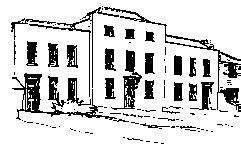This tour is based on “A Walk in Southgate” written for and published by the Southgate Civic Trust published in 1989. It is reproduced here with the kind permission of the Southgate Civic Trust.
If you would like to join the Southgate District Civic Trust, please contact Alastair Palmar, Treasurer, 5 Tintern Gardens, Southgate N14 6AS.
A historical tour for pedestrians – centred on the Southgate Green Conservation Area (Allow about 1/2 hours for this walk)

Southgate came into being as a result of the creation in about the year 1200 of the Enfield Chace, the village being centred upon the South Gate of this royal hunting ground. It is known, however, that the area was populated well before this; in Norman times it was within the manor of Geoffrey de Mandeville, who seized an already existing Saxon estate. Indeed, there has probably been continuous occupation of the district from at least the Bronze Age, the date of the barrow once in Barrowell Green, Winchmore Hill. Early Iron Age coins found in New Southgate also suggest occupation during this era.
During the time of the Chace the local peasants had the right to graze animals upon it, but the woodlands of Southgate were far more extensively exploited, producing timber for building, fuel, bark (for the tanners of Enfield and Edmonton) and charcoal, the latter industry surviving into the early 19th century. By this time, however, Southgate had become the residence of a number of owners of large estates as well as the home of arable farmers; but signs of the impending urbanisation of the 20th century were, even then, at hand.
In 1851, with the opening of Colney Hatch Station on the Great Northern Railway, the construction of the New Southgate housing estates began, although the Walker family of Arnos Grove stopped the development spreading north of Bowes Road, and extensive house building did not begin in Southgate until the early 1900s. The opening of the Piccadilly Tube extension in 1932/33 encouraged further large scale housing development, and soon the transformation of Southgate into a residential suburb was complete. The last great estate, Trent Park, remained in private hands until 1939, and, almost miraculously, farming continues there today.
Southgate Circus
1. No more appropriate spot could be chosen to start the walk than the site of the South Gate itself. This is marked by a plaque on the entrance to Mallinson House at the Southgate Circus end of Chase Road.
2. Across the busy Circus is the Underground Station and parade of shops. Its striking design, making it the hub of the Circus, is by Sir Charles Holden, architect of the Senate House of London University. Four of his local stations, including this one, are listed as buildings of special architectural importance. Before the coming of the Tube, the Circus was a collection of old buildings called Bunker’s Comer, named after a firm of wheelwrights situated there.
The High Street
3. Down the High Street, on the right hand side, a plaque affixed to the offices at No. 151 marks the site of the village hall, which in 1882 housed the early meetings of the Southgate Local Board of Health, predecessor of Southgate Urban District Council. The road opposite is named after John Bradshaw, who lived at the Grange (now demolished) and was a great benefactor of Southgate.
4. Further along the High Street stands Southgate Technical College, built in 1963 (and since enlarged) on sites once occupied by the nursery and market gardens of seedsmen R.& G. Cuthbert and by the estate of the Wilderness, one of Southgate’s large houses.
5. Immediately opposite, behind a high wall and surrounded by many fine old trees, is Southgate House, a building of yellow brick with stone dressings and a curved porch, dating from about 1780. The plaque near the front door records its occupation by Baron Lawrence (who relieved the seige of Delhi) from 1861 until his appointment as the first Governor-General of India in 1864. The house was used by Minchenden School from 1924 to 1987. (It is now used by Southgate College.-SGA)
 Southgate House now used as an administrative block for Southgate College
Southgate House now used as an administrative block for Southgate College
Nos. 11 1-1 17 High Street
6. Opposite the boundary wall of Southgate House is a fine row of Georgian houses, Nos. 107-115 High Street, representing another facet of I8th century Southgate – that of the middle classes and professional men. During the 19th century No. 107 became the Zion House Academy, kept by Robert Blagden, a land surveyor. He gave his name to Blagdens Lane.
7. The walk turns right down Blagdens Lane, at the end of which stands Minchenden Lodge. It was once owned by the landlord of the Cherry Tree Inn on Southgate Green; Queen Victoria and Prince Albert are reputed to have stayed there one night after they had officially opened Colney Hatch Asylum in 1849. The tall obelisk in the garden is thought to have marked the boundary between Middlesex and Hertfordshire.
8. Down Blagdens Close, through an area of modern housing, a footpath on the left leads to the Close, a development of the 1930s in which several mature trees were allowed to remain.
9. The walk should be continued by turning right down the Close, then left along Mayfield Avenue, named after a large house on the site. Mayfield Avenue leads into Balaams Lane. Near the end, on the left, is a row of cottages originally built in 1792 and rebuilt in 1911. The clapboarding is a modern addition.
10. At the end of Balaams Lane a short detour should be made to the right along the High Street to see the site of Eagle Hall, opposite the Woolpack public house. Eagle Hall was the birthplace, in 1784, of James Henry Leigh Hunt, poet and essayist, as recorded on a blue plaque fixed to the wall of the nearby synagogue. The house actually stood immediately to the right of the shop with the triangular pediment.
(The synagogue has now been demolished and the plaque has therefore been removed. A new block of flats has been built and the original shops replaced.- SGA)
11. The walk returns into Balaams Lane. On the left are the Baird Memorial Homes (1894), named after the first vicar of Christ Church. A modern wing, in keeping with the original building, has been added. There is an explanatory plaque on the front which faces the church across the field.
12. Next to the Baird Memorial Homes is the entrance to a footpath round part of the Walker Cricket Ground. The Walker Ground, formerly Chapel Fields, was purchased by Isaac Walker from the third Duke of Chandos in 1853 to enlarge his estate, and his son, John, laid out the land for cricket soon afterwards. He was the eldest of seven brothers (none of whom ever married), and he made this one of the principal cricket grounds in the country. Several of the brothers played for England, and in 1858 10,000 people saw the Sixteen of Southgate beat United All England on this ground. The footpath continues to the car park opposite Christ Church.
Christ Church
13. Christ Church was built in 1862. It was designed by Sir George Gilbert Scott, and contains windows of Pre-Raphaelite glass by Rossetti and Bume-Jones. The wall around the church is 17th century. In this wall, at the east end of the church, is a small door, presumably the private entrance for the family at nearby Amolds.
14. In the churchyard at the west end of the church is the site of the Weld Chapel. This was built in 1615 by Sir John Weld, who lived in Amolds, and it was replaced by the present church.
15. Adjoining the churchyard, and reached through a gate in the wall, is the memorial garden containing the Minchenden Oak. This tree, a survivor of the ancient Forest of Middlesex, is reputed to be at least 800 years old.
The Green
16. Southgate Green, the centre of a Conservation Area, was the hub of the hamlet of South Street in years gone by, and included a large pond and stocks. In 1928 the pond was filled in, but a pair of stocks (not the original) remains. Close by is a horse trough erected by the Metropolitan Drinking Fountain and Cattle Trough Association.
Eighteenth cemtury Georgian Houses on the North side of the Green
Arnoside, Essex House and Old House
17. The north side of the Green contains a mixture of 18th century and modern buildings, the new Parish Centre being an example of how well the new can blend with the old. Old House, Essex House and Amoside are characteristic of the 18th century from which they date. The bell on the roof of Amoside is a reminder that the house was once used as a school.
18. The east side of the Green contains some interesting properties. Ingleside (No. 41) and Ash Lodge (No. 40) are 19th century houses; Ash Lodge was used as the first office of the Southgate Local Board of Health in 1881, as recorded on the plaque. Norbury House (No.39) and Sandford House (No. 38) are late 18th century, with a more recent addition to the latter. Next to them is the modern bank which replaced the house in which the Reverend Benjamin Waugh, founder of the N.S.P.C.C., once lived.
19. The row of Georgian cottages next to the bank was designed for the Valentine Poole Trust by Michael Searles (architect of the Paragon at Blackheath) and built in the late 18th century. The plaque records their reconstruction with the help of Southgate Civic Trust in 1981. This work included removal of the shop fronts which had been a feature of the cottages for many years.
20. The Cherry Tree Inn is one of the oldest buildings in Southgate. There was an inn or public house on the land when it was given by Valentine Poole for the benefit of the poor of Bamet in 1624, and the Charity Trust has a record of the Cherry Tree back to 1721. The buttresses and porch were added in 1923 to prevent the walls bulging any further. Two recesses with holes in the ceiling can be seen on the left hand side of the archway entrance to the inn yard. These were to allow the long coach poles to be stored for the night after coaches had been unloaded and unhorsed.
Cannon Hill
21. Across the road an avenue of red chestnut trees leads to another Southgate House, originally called Amos Grove, and now the offices of an insurance company. The centre portion is the house built in 1723 for James Colebrooke and purchased by Isaac Walker in 1777, the Walker family (which included the seven cricketing brothers) retaining possession of it for 141 years’ The two wings were added after the building was sold for offices to the North Metropolitan Electric Power Company in 1928. The walls and ceilings of the entrance hall in the mansion have some fine murals depicting the triumphs of Julius Caesar and painted by G. Lanscroon when the house was built. The electric lamp standards in the drive came from the Wembley Exhibition of 1924.
(The house has now been divided and now has two names. The central and Northern wing are occupied by the Beaumont care centre as Southgate House. The southern wing has been re-developed as flats and is known as Lulworth Court. -SGA)
22. Further down Cannon Hill on the opposite side are three houses representing 18th century Southgate and now adapted to modern requirements. Cannon House is used as a social club by St. Monica’s Church, Palmers Green; the timber built Coach House next door was originally the stables and coach house of Cannon House, and is now a private residence; the Hermiitage (one of the few thatched houses remaining in London) is divided into two homes. The Hermitage has since reverted to one home
The walk ends at the Village Gates sign at the comer of Cannon Hill and Aldermans Hill. Across the road is Broomfield Park which contains Broomfield House, a large mansion of mainly 18th century origins, though parts are older. In the late 19th century this was the home of Ralph Littler, who took a leading part in the creation of Southgate as a separate local government entity in 1881.
Broomfield House was burnt down in a fire in 1984 and has subsequently suffered farther damage by fire and vandalism. The original Broomfield House was the oldest house in Southgate. It was originally a modest farmhouse but by 1624 it had become a large house. It is reputed to have been used by James I as a hunting lodge and it is thought that the metal hooks which can still be seen on the main entrance gate, were used for hanging venison from the hunt.
(In 1925 the house opened as Broomfield Museum with a health centre on the upper floor and this is how it continued to be used until it was destroyed by fire. – SGA)
Bibliography
W. Bettesworth The Walkers of Southgate: A Famous Brotherhood of Cricketers (1900)
Walker Round The Story of Southgate and Winchmore Hill (1906, reprinted 1976)
T. Mason The Story of Southgate and other Local Essays (1948)
T. Mason A Southgate Scrap-book (1948)
H. Newby ‘Old’ Southgate (1949)
H. Newby A Few More Leaves of ‘Old’ Southgate (1950)
T. Lewis and D. Pam William and Robert Cecil as Landowners in Edmonton and Southgate 1561-1600 (Edmonton Hundred Historical Society 1972)
D. Pam Southgate and Winchmore Hill: A Short History (1982)
A. Dumayne Southgate: A Glimpse into the Past (1987)


